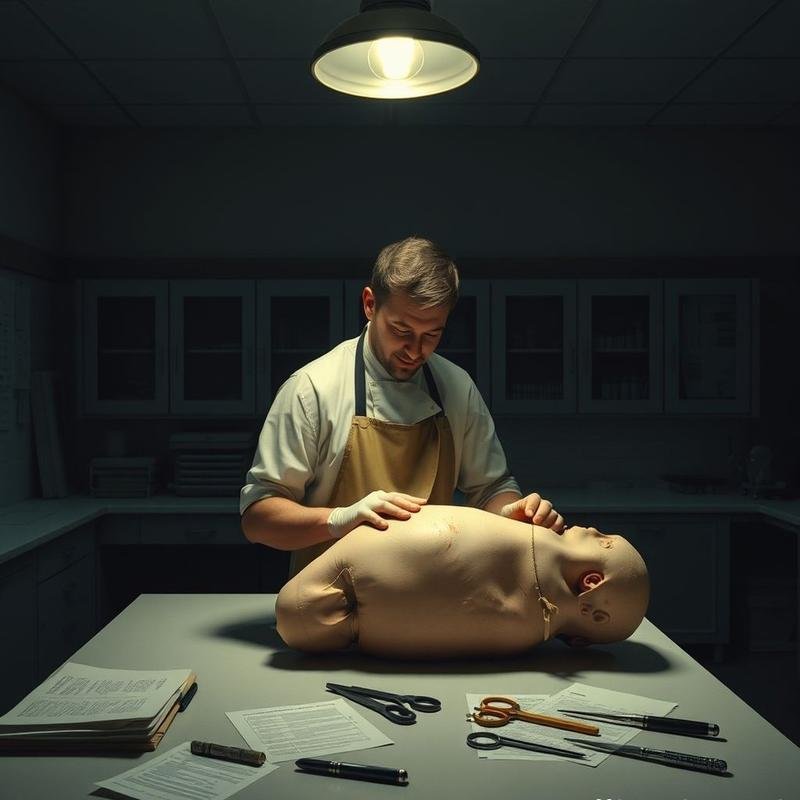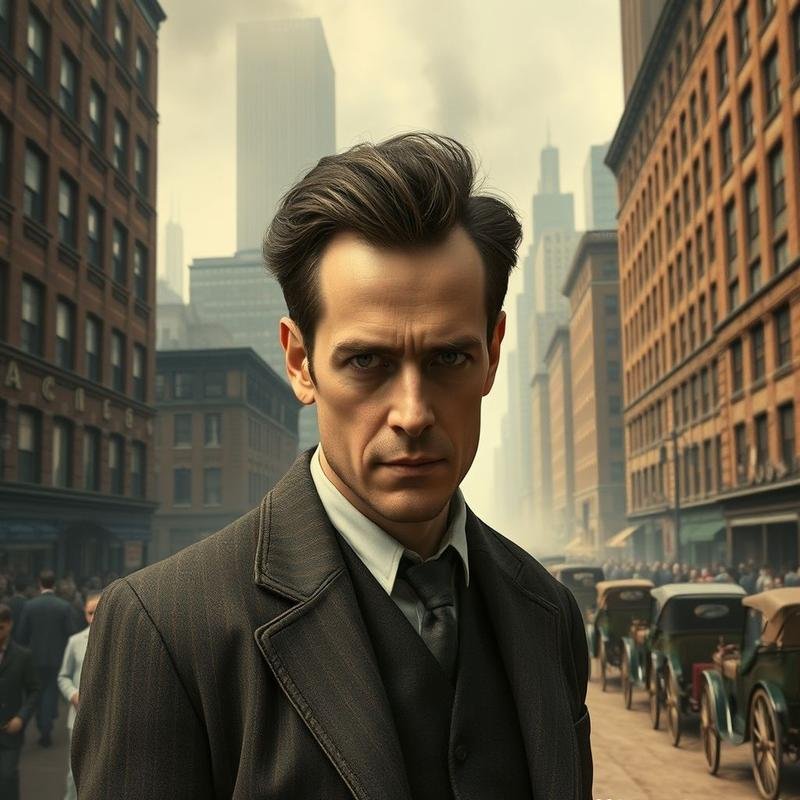Holmes: How did a con artist become a murderer? 🤯 Hotel of Horror

H.H. Holmes: Hotel of Horrors & Murderous Rise
In the late 19th century, amidst the prevailing industrial optimism in Chicago, a sinister figure emerged: Dr. Henry Howard Holmes, or H. H. Holmes. He was not merely a skilled con artist but a meticulous architect of death. A fraudulent physician, a deceptive pharmacist, and an ambitious businessman – these were the masks concealing a lurking monster. His charming facade concealed dark motives, fueled by a troubled childhood and an obsession with corpses and anatomy. As the city prepared for the 1893 World’s Columbian Exposition, Holmes was constructing his diabolical masterpiece: a three-story hotel specifically designed for murder. It featured secret passages, soundproof rooms, peepholes, and bolted doors leading to unknown destinations. This was not simply a hotel but a labyrinth of terror, where victims mysteriously disappeared, becoming part of Holmes’s bloody legacy. Was this hotel merely a crime scene, or a reflection of a tormented psyche? It would become the stage for some of the most heinous chapters in American criminal history.
Herman Mudgett: The Early Years
Herman Mudgett, H. H. Holmes’s given name, had origins far removed from the bright lights of Chicago. Born in 1861 in Gilmanton, New Hampshire, he was raised in a harsh environment. His father was authoritarian, and his mother excessively religious. Accounts describe a troubled childhood, marked by bullying and a peculiar inclination to dissect small animals, a practice that ignited his curiosity about the human body and its anatomy. Was this merely innocent scientific curiosity, or the nascent stage of something more sinister? Was his cruelty toward small animals a training ground for something far worse? During his medical studies at the University of Michigan, Mudgett initiated his career in fraud. He stole corpses from the laboratory, meticulously disfigured them, and then forged insurance documents, reaping substantial profits. These actions were not minor infractions but a clear indication of his willingness to manipulate the law and ethics for personal gain. Was this gradual descent into crime inevitable from the outset?
Transformation into H.H. Holmes
After graduating, he relocated to Chicago. There, he abandoned Herman Mudgett and became H. H. Holmes, embarking on a new life built on deception and forgery. He acquired a pharmacy in Englewood, a district preparing to accommodate the crowds flocking to the World’s Fair. However, Holmes’s ambitions extended beyond dispensing medicine; he harbored a darker vision: to construct a hotel that would become the stage for his horrific crimes. This period marked a crucial transformation, transitioning from financial fraud to the planning of organized killings, driven by an inherent desire to control and inflict harm on others. Had this desire been dormant within him since childhood, or did it develop and flourish under specific circumstances? Was the society of that era, with its moral contradictions and pervasive corruption, an ideal incubator for the development of such a personality?
The 1893 World’s Fair: An Opportunity for Evil
The 1893 World’s Fair in Chicago, known as the Columbian Exposition, was more than just a celebration of the 400th anniversary of Columbus’s arrival in America; it presented a golden opportunity for H. H. Holmes. Consider a city with a dramatically increased number of visitors, with over 27 million people converging on Chicago in just six months. Amidst these massive crowds, the disappearance of an individual becomes significantly easier, does it not? The fair served as the perfect cover. A city teeming with strangers, workers, builders, and visitors from around the globe. This massive influx contributed to a state of apparent chaos, where suspicious activities could easily be concealed. Holmes, closely observing the situation, recognized in this event an unparalleled opportunity to realize his morbid ambitions.
The Murder Castle: A Deadly Spiderweb
Holmes exploited the visitors’ need for accommodation, as the demand for hotels and apartments was exceedingly high. Holmes’s hotel, constructed a few miles from the fair, was not merely a place to stay but a meticulously crafted death trap, akin to a deadly spiderweb. The intricate design of the hotel, which he personally built and controlled every detail of, allowed him to conceal torture chambers, secret passages, and doors that led nowhere. Amidst the fair’s noise and boisterous celebrations, Holmes was perpetrating his heinous acts, capitalizing on the state of distraction and frenzy that gripped the city. The disappearance of a hotel guest, amidst thousands of visitors, would not elicit much suspicion. The World’s Fair provided the perfect veil to conceal his crimes, making him America’s first serial killer to have such a unique opportunity. The irony is horrifying. How could an event symbolizing progress and prosperity provide the perfect cover for murder and brutality?
Architectural Madness
Holmes’s hotel, or the Castle as the locals called it, remained an architectural enigma, a true embodiment of its owner’s madness. It was not simply a hotel but a deadly maze ingeniously designed. Three interconnected floors of horror, but with an absurd interior design, devoid of any logic or consistency. Rooms connected to dead-end corridors, staircases leading to solid walls, and doors opening into dark voids. This diabolical layout, overseen by Holmes himself, was intended to mislead and disorient victims, transforming the hotel into an inescapable death trap.
Secret Passages and Torture Chambers
The secret passages were a hidden network spread throughout different parts behind the walls, under the floors, and above the ceilings. Some were barely wide enough for one person, while others were small rooms. The padded revolving doors transported victims to the hotel’s lower vaults, where unimaginable horrors awaited them. Holmes not only created hidden passages but also installed trapdoors in the floors of some rooms, leading directly to the hotel’s basement, where he established an operating room equipped with surgical and anatomical instruments. Here, he practiced his horrific rituals, exploiting the isolation of the location and its disconnection from the outside world. In addition, Holmes equipped the hotel with a complex ventilation system, allowing him to pump toxic gases into the rooms, killing his victims by suffocation. The hotel was a complete killing machine, meticulously designed by Holmes to become the stage for his heinous crimes and a shrine to his innocent victims. These horrifying details, revealed by subsequent investigations, reflect the extent to which Holmes was immersed in his morbid world, transforming him into a human monster devoid of mercy. Was this hotel a true reflection of Holmes’s twisted mentality?
The Victims: Stories Forgotten
After Holmes transformed his hotel into a human slaughterhouse, the stories of his victims began to surface; stories forgotten amidst the hustle and bustle of the World’s Fair, but worthy of being told. Julia Conner, a young woman in her twenties, an ambitious pharmacist in a Chicago suburb. She was enticed by Holmes’s advertisement for a job in his pharmacy inside the hotel, an attractive offer with a generous salary and comfortable accommodation. But did she know that Holmes was not looking for an employee but for a victim? A vulnerable woman, easily manipulated and exploited. Holmes exploited her trust and her responsibility towards her younger sisters to tighten his grip on her. Then Emily Cigrand, a young woman who came to Chicago with her family to attend the fair. She soon met Holmes, who presented himself as a wealthy and brilliant businessman, and she fell into his trap. He promised her marriage, but instead, he led her to his ill-fated hotel, where her fate was sealed. Holmes exploited her naivety and her desperate need for money, promising her a rosy life, but he robbed her of her most precious possession: her life. As for Minnie Williams, a young and ambitious teacher, she came to Chicago in search of better job opportunities. She rented a room in Holmes’s hotel and soon became another victim of his. These women, and many others, became mere statistics in Holmes’s heinous crime record. Tragic stories that remind us of the high price that innocent people paid for the ambitions of a sick man.
The Art of Deception
Holmes was not just a killer but an artist of deception, skilled at manipulating others and exploiting their vulnerabilities. He carefully studied his victims, selecting them based on their susceptibility to his influence. He exploited their need for money, their ambition, or even their naivety, to lure them into his trap. He mastered the art of acting, appearing as a kind and friendly man, while concealing his evil intentions behind this facade. Did Holmes genuinely believe he was evading detection? Or was a subconscious desire for exposure driving him towards his eventual downfall?
Justice Served
Ultimately, Holmes was brought to justice. He was arrested in 1894, tried for the murders of Julia Conner and Emily Cigrand, convicted, and sentenced to death by hanging. Holmes was executed in 1896, but his dark legacy continues to cast a shadow over American criminal history. The Hotel of Horrors, which was subsequently demolished, became a symbol of absolute evil and a constant reminder of the human capacity to commit the most heinous crimes. Holmes’s story raises profound questions about the nature of evil and the motivations that drive an individual to commit such brutal acts.
Conclusion
The story of H. H. Holmes is more than just a narrative of gruesome events. It is a descent into the depths of the dark human psyche and an exploration of the factors that might drive someone to transform from a con artist into a serial killer. After considering these horrifying details, do you believe that societal factors and personal circumstances alone are sufficient to explain H. H. Holmes’s transformation from a con artist into a serial killer, or are there deeper and more complex psychological motives underlying his actions? Share your opinions in the comments.







